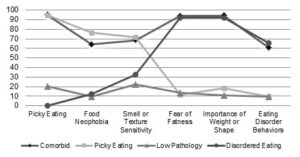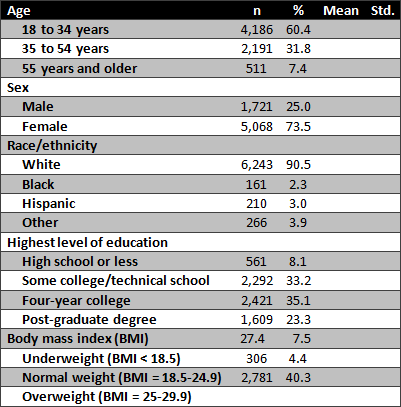Completed Research Projects 2008-2013
Adult Selective Eating: A Model for the Study of Self Regulation
Investigator: Nancy Zucker
Overview
Individuals differ in their capacities to sense and decipher internal visceral cues and such variation may be a critical mediator influencing individual capacities for self-regulation. While the experience of the body is not a diagnostic feature of more traditional disorders of self-regulation (e.g., ADHD, substance abuse), yet regular nutrition, sleep, and emotion regulation inevitably become/are disrupted during the course of disorders, may prolong and complicate illness course and intervention, and may even increase vulnerability to disorder emergence. Individuals’ capacities to sense and respond to visceral cues may not only influence vulnerability for such dysregulation, but may also impact the experience of the reinforcing aspects of psychiatric symptoms (e.g. visceral changes associated with drugs of abuse). Thus, study of individuals who exhibit superior sensitivity to visceral sensation and adaptive responsivity to visceral states may inform the emergence of self-regulation. In this study we describe how study of adults who are selective eaters; i.e. those who consume a limited variety of food and report extreme sensitivity to sensory experiences of taste and smell, may inform the development and maintenance of self-regulatory capacities more generally.
This pilot meets aim 2 of the C-StARR; to conduct basic scientific studies of regulatory processes that will be translated into novel prevention approaches to adolescent substance use.

Methods
We constructed a web-based survey for adults who identified themselves as selective or picky eaters. The survey contained items derived from descriptions of picky/selective eating in children, a diagnostic screening tool for eating disorders (EDDS), a measure of symptoms from the obsessive/compulsive spectrum, a measure of clinical impairment, and items related to sensory experience. The survey also incorporated proposed criteria for Avoidant/Restrictive Food Intake Disorder, a proposed diagnostic category under review for the DSM-V to categorize those individuals for whom food restriction and avoidance impairs function, but the restriction is not motivated by fear of weight gain. The first 6895 adults who self-identified as selective eaters constitute the sample for the current analysis. Latent class analysis (LCA) was performed to identify groups based on patterns of picky eating and disordered eating symptoms. Dichotomous indicator variables for picky eating included: 1) responding “all of the time” to the question “do you consider yourself a picky eater?” (picky eater); 2) responding “rarely or never” to the question “are you willing to try a food you have never eaten before?” (food neophobia); and 3) responding “all of the time” to either “are you sensitive to the smells of food?” or “are there certain textures of food that you refuse to eat?” (smell or texture sensitivity). Dichotomous indicator variables for disordered eating included: 1) clinically significant fear of fatness (score > 4 on EDDS item 2); 2) clinically significant importance of weight or shape (score > 4 on EDDS item 3 or EDDS item 4); and 3) endorsement of at least one eating disorder behavior (i.e., binge eating, self-induced vomiting, laxative or diuretic misuse, fasting, or excessive exercise) per week during the past three months. One-to eight-class models were fit using Latent GOLD version 4.5 (Statistical Innovations, Inc., Belmont, MA). Parameters were estimated using maximum likelihood. The bootstrap likelihood ratio test was used to compare successive models; a significant change in -2 log-likelihood indicated that the model with the larger number of classes provided a better fit to the data.
themselves as selective or picky eaters. The survey contained items derived from descriptions of picky/selective eating in children, a diagnostic screening tool for eating disorders (EDDS), a measure of symptoms from the obsessive/compulsive spectrum, a measure of clinical impairment, and items related to sensory experience. The survey also incorporated proposed criteria for Avoidant/Restrictive Food Intake Disorder, a proposed diagnostic category under review for the DSM-V to categorize those individuals for whom food restriction and avoidance impairs function, but the restriction is not motivated by fear of weight gain. The first 6895 adults who self-identified as selective eaters constitute the sample for the current analysis. Latent class analysis (LCA) was performed to identify groups based on patterns of picky eating and disordered eating symptoms. Dichotomous indicator variables for picky eating included: 1) responding “all of the time” to the question “do you consider yourself a picky eater?” (picky eater); 2) responding “rarely or never” to the question “are you willing to try a food you have never eaten before?” (food neophobia); and 3) responding “all of the time” to either “are you sensitive to the smells of food?” or “are there certain textures of food that you refuse to eat?” (smell or texture sensitivity). Dichotomous indicator variables for disordered eating included: 1) clinically significant fear of fatness (score > 4 on EDDS item 2); 2) clinically significant importance of weight or shape (score > 4 on EDDS item 3 or EDDS item 4); and 3) endorsement of at least one eating disorder behavior (i.e., binge eating, self-induced vomiting, laxative or diuretic misuse, fasting, or excessive exercise) per week during the past three months. One-to eight-class models were fit using Latent GOLD version 4.5 (Statistical Innovations, Inc., Belmont, MA). Parameters were estimated using maximum likelihood. The bootstrap likelihood ratio test was used to compare successive models; a significant change in -2 log-likelihood indicated that the model with the larger number of classes provided a better fit to the data.
Results
Latent class analysis revealed a clear, four-class solution (see Figure 1). The largest class (n = 2,195; 31.8%) was comprised of individuals who endorsed high rates of picky eating and disordered eating symptoms (comorbid group). The second largest class (n = 1,981; 28.7%) reported high rates of picky eating symptoms and low rates of disordered eating symptoms (picky eating group). The third largest class (n = 1,478; 21.4%) endorsed minimal picky eating or disordered eating symptoms (low pathology group). Finally, the smallest class (n = 1,241; 18.0%) reported low rates of picky eating symptoms and high rates of disordered eating symptoms (disordered eating group). Chi square analyses revealed significant differences among the latent classes on all six indicators. Further, there were distinct patterns of impairment across latent classes. While the Combined group endorsed the highest degree of impairment overall followed by the Eating Disordered Group, the picky eating group endorsed an equivalent level of social anxiety and social isolation relative to the combined group and higher than the pure eating disordered group.

Significance and Clinical Implications
Individuals with anorexia nervosa have a 57-fold greater likelihood of death by suicide, while social isolation more generally characterizes individuals with eating disorders. Findings from the current study indicate that food selectivity, a feature associated with sensitivity to taste and smell, may contribute to such social isolation and highlights entirely novel targets for intervention. Further, the role of sensory relative to cognitive influences on decision-making, while well-recognized, may highlight the importance of this individual difference in helping to understand self-regulatory processes.